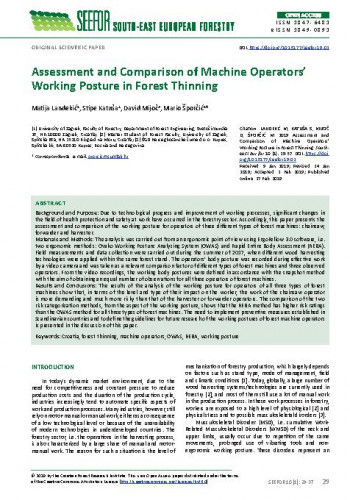Background and Purpose: Due to technological progress and improvement of working processes, significant changes in the field of health protection and safety at work have occurred in the forestry sector. Accordingly, this paper presents the assessment and comparison of the working posture for operators of three different types of forest machines: chainsaw, forwarder and harvester. Materials and Methods: The analysis was carried out from an ergonomic point of view using ErgoFellow 3.0 software, i.e. two ergonomic methods: Ovako Working Posture Analyzing System (OWAS) and Rapid Entire Body Assessment (REBA). Field measurements and data collection were carried out during the summer of 2017, when different wood harvesting technologies were applied within the same forest stand. The operators’ body posture was recorded during effective work by a video camera and was taken as a relevant comparison factor of different types of forest machines and three observed operators. From the video recordings, the working body postures were defined in accordance with the snapshot method with the aim of obtaining an equal number of observations for all three operators of forest machines. Results and Conclusions: The results of the analysis of the working posture for operators of all three types of forest machines show that, in terms of the level and type of their impact on the worker, the work of the chainsaw operator is more demanding and much more risky than that of the harvester or forwarder operators. The comparison of the two risk categorization methods, from the aspect of the working posture, shows that the REBA method has higher risk ratings than the OWAS method for all three types of forest machines. The need to implement preventive measures established in Scandinavian countries and to define the guidelines for future research of the working postures of forest machine operators is presented in the discussion of this paper.
Sažetak

 South-east European forestry : SEEFOR : international scientific journal in field of forestry : 10,1(2019) / editor-in-chief Dijana Vuletić.
South-east European forestry : SEEFOR : international scientific journal in field of forestry : 10,1(2019) / editor-in-chief Dijana Vuletić.